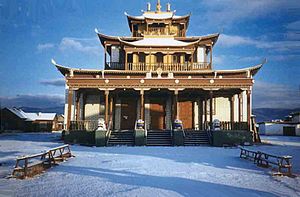- Datsan
-
Datsan (Mongolian: Дацан, Russian: Дацан) is the term used for Buddhist university monasteries in the Tibetan tradition of Gelukpa located throughout Mongolia, Tibet and Siberia. As a rule, in a datsan there are two departments—philosophical and medical. Sometimes to them is added the department of the tantric practices where the monks study only after finishing education in the philosophical department.
In pre-revolutionary Russia, datsans traditionally existed only in the Buryat territories, most of those now included in Buryatia and Transbaikalia (a number of datsans there has been reconstructed or started since the early 1990s). There was a difference with Tibetan administrative idea: in Tibet, several datsans were education-centered parts of larger organizations, as Drepung, Ganden, and Sera Monastery in Gelugpa tradition. In Russia, datsans were not parts of a larger entity, but rather independent educational and religious centers. In Buryat Buddhism, terms "Buddhist monastery" and "Datsan" are interchangeable, as other monastery organization forms found in Tibetan Buddhism elsewhere, were not present.
Contents
List of datsans in Mongolia
- Mamba datsan
- Geser datsan
List of datsans in Russia
Datsans were officially acknowledged in the Imperial Russia in 1734. By statute of 1853 there were two recognized datsans in the Irkutsk government and others in the Zabaykalsky Government. The first datsan in Europe was Gunzechoyney datsan in St. Petersburg.
Between 1927 and 1938 all 47 datsans existed in Buryatia and Transbaikalia were closed or destroyed. In 1945 the Ivolginsky datsan was opened, and several years later the Aginsky datsan resumed operations. The following ten datsans were not opened until 1991.
- Khambyn Khure datsan (Улан-Удэнский Дацан Хамбын Хурэ) in Ulan-Ude
- Aginsky datsan (Агинский Дацан) in Aginskoye
- Kurumkansky datsan (Курумканский Дацан) in Kurumkan
- Sartuul Gegetuy datsan (Сартуул Гэгэтуйский Дацан) in Gegetuy
- Egituysky datsan (Эгитуйский Дацан) in Egituy
- Sanaginsky datsan (Санагинский Дацан) in Sanaga
- Ivolginsky datsan (Иволгинский Дацан) in Verkhnyaya Ivolga
- Kizhinginsky datsan (Кижингинский Дацан) in Kizhinga
- Baldan Breybun datsan (Дацан Балдан Брэйбун) in Murochi
- Tugnuysky datsan (Тугнуйский дацан) in Mukhorshibir
- Okinsky datsan (Окинский дацан) in Orlik
- Tamchinsky datsan (Тамчинский дацан) in Gusinoozyorsk
- Kyrensky datsan (Кыренский дацан) in Kyren
- Khoymorsky datsan (Хойморский дацан) in Arshan
- Ugdansky datsan (Угданский дацан)
- Ust-Ordynsky datsan (Усть-Ордынский (Абатанатский) дацан) in Ust-Ordynsky
- Aninsky datsan (Анинский дацан) in Ana
- Chesansky datsan (Чесанский дацан) in Chesan
- Tsugolsky datsan (Цугольский дацан) in Tsugol
- Saint Petersburg Tibetan Temple
- Gunzechoyney datsan (Дацан Гунзэчойнэй) in Saint Petersburg
See also
- List of Tibetan monasteries
- Buddhism in the Russian Federation
External links
- (Russian) List of datsans in Buryatia, Chita and Irkutsk Oblasts
- (Russian) Official site of the Gunzechoyney datsan
- (Russian) Datsans
Categories:- Tibetan Buddhist monasteries
- Buddhism in Russia
- Buddhist monasteries in Russia
Wikimedia Foundation. 2010.

